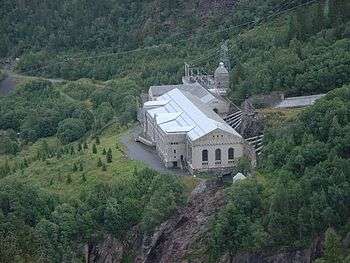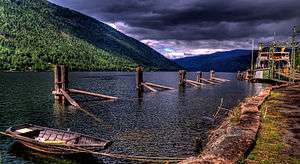Rjukan
Rjukan is a town (population 3,400) in the Tinn municipality of Telemark, Norway. The town was founded in 1908 by Sam Eyde, who started the plan of building a city from scratch, after buying the renowned Rjukan waterfall to make electric power for fertilizer production. The Rjukan-Notodden Industrial Heritage Site is on UNESCO's World Heritage list since 2015.

Understand

The small town of Rjukan emerged because of the hydro power and factories producing artificial fertilizer established there. A short railway line connected the factory and power plant to Tinn lake where a special railway ferry carried wagons along the lake with further connections to Notodden and the ocean.
The name Rjukan refers to the Rjukan waterall (literally the "steaming" or "smoking" waterfall), this waterfall was used at the Vemork hydro power station (largest in the world when it was constructed in 1911). The waterfall has a total drop of about 240 meters, of which about 100 meters is vertical. Because of the hydro power the waterfall is now seen occasionally during summer. The waterfall was in the 1800s regarded as Norway's top tourist attraction, and one of the first outside visitors reported that he had discovered the "tallest waterfall in the world" (a slight exaggeration). Others described it as a "lovely and mighty waterfall beyond imagination."
Rjukan sits in a deep, narrow valley beneath the high barren plateau, partly known as Hardangervidda. A single distinct summit, Mount Gausta (1883 m.a.s.), rise above the plateau. Mt Gausta is probably the summit that offers the widest panorama, it has been estimated that the panorama covers some 60,000 km2 (twice the size of Belgium). Sam Eyde proposed an idea of bringing winter light to Rjukan about a century ago. Due to its location in a deep valley, Rjukan does not see sun between October and March. A project of mirrors installed on top of an adjacent mountain turning toward the sun as it moves along the sky and reflecting its light to the town square was completed in 2013.
During the second world war the German occupants produced heavy water at the Vemork facilities in Rjukan. Heavy water could potentially be used to produce nuclear weapons and the allies decided to destroy the production facility. In a daring and bold operation, a group of Norwegian commandos flown in from Britain managed to enter the plant and blow it up (no shots were fired and nobody killed). The movie Heroes of Telemark (1965) is based on the operation and was produced in Rjukan by Kirk Douglas (with son Michael in one his first jobs in the film industry).
Get in
By car
Recommended route is Oslo-Drammen-Kongsberg-Bolkesjø-Rjukan (180 km; 2½ hours). Alternative route Oslo-Drammen-Kongsberg-Notodden-Rjukan takes 15 minutes longer. From western Norway, you take off E-134 to Arabygdi and then on to Road 37.
By bus
Search on https://en-tur.no. Normal travel time is 3 hours from the capital Oslo. Most common is bus all the way with change in Notodden (the Haugesund express and local bus), or train to Kongsberg and bus to Rjukan with change in Notodden.
Get around
See
- 🌍 Mount Gausta (Gaustatoppen), Gaustaområdet (Situated 15 km east of the town.), e-mail: post@visitrjukan.com. Highest summit south of Hardangervidda and highest in Telemark, a distinct profile. About 1/6th of Norway can be seen on clear days. 30-40 000 hike to the summit every year, taking approximately 2 hours from Stavsro, where you can park the car. You can also take the Gaustabanen Cable Car inside the mountain. Free admission.
- 🌍 Norwegian Industrial Workers Museum (Norsk Industriarbeidermuseum), Vemork (Situated 7 kilometers west of town center.), ☎ +47 35099000, e-mail: post@nia.no. 1 May-14 Jun: Daily 10AM-4PM, 15 jun-14 Aug: Daily 10AM-6PM,15 Aug-30 Sep Daily 10AM-4PM, 1 Oct-30 Apr: Tue-Fri: Noon-3PM, Sat-Sun: 11AM-4PM, Mind: Closed 17 May, 24-26 Dec, 31 Dec-1 Jan. Situated on the very grounds of the Heavy Water Sabotage during World War II, Vemork is having several exhibitions about the local history of the indistrial worker as well as war exhitbitions. Adults: kr 80, Students: kr 70, Seniors: kr 70, Children: kr 50, Grouprabates from 15 persons minus kr 5 each person.
- Tinn Museum (Situated 5 kilometers east of Rjukan town center.), ☎ +47 35099000, e-mail: post@nia.vemork.no. Has a vast collection of old houses, and old things. Showing how life was in the rural parts of Tinn and in old times, before the town Rjukan was established.

- 🌍 Rjukan railway (Rjukanbanen), Mæl (14 km NE of Rjukan along rd. 37, at the shore of Tinn lake). Jun 15 - Aug 15 10:00 - 18:00. The 16 km long railway was operational between 1927 and 1991. In Mæl cargo (consisting mainly of chemicals produced in Hydro's fertilizer plant) was loaded onto ferries for transport across the lake to Tinnoset. In 1944 a steam ferry Hydro was sunk on the way from Mæl (as a part of Norwegian heavy water sabotage) with a cargo of heavy water for Nazi nuclear weapon project. Adults: kr 50, Children (8+): kr 25.
Do
%2C_the_highest_mountain_in_southern_Norway..jpg)
- Gaustabanen Cable Car, Gaustaområdet (Situated 15 km east of the town.). A small train takes you 1 kilometer into the mountain, before you go on the cable car which takes you almost 1 kilometer up towards the top of the summit Gaustatoppen, Southern Norways highest summit, from which you can see 1/6th of Norway on clear days. Former military use, which was open to public in 2011.
- Gaustablikk Skisenter, ☎ +47 35081422. Norways 6th biggest skiing resort.
- Rjukan Rockfestival, ☎ +47 99224485, e-mail: post@rjukan-rockfestival.no. Two day rock festival second weekend in June. Established in 2000.
Buy
- Heavy Water You might buy an ampul of real heavy water at the Industrial Workers Museum or at VisitRjukans tourist office in town center. Heavy water is 10% heavier than normal water.
- Tinn knife The Tinn community is traditionally famous for they blacksmiths, and a Tinn knife is attractive among collectors.
- Goat cheese You might buy great high quality cheese made the traditional style in the mountain.
- Rakfish Trout that is fermented for several months. A traditional speciality.
- Potato lefse Before christmas you might buy this delicate traditional potato lefse, which is a must at christmastime.
Eat
- Dong Fang Kinarestaurant. Chinese cuisine in town center.
- Park Hotel Restaurant. Norwegian cuisine in town center.
- Rjukan Hytteby Kro. Norwegian cuisine in town center.
Drink
Sleep
Connect
- Rjukan Tourist Office, Torget 2, ☎ +47 35082560, e-mail: info@visitRjukan.com. Public tourist office with good opening hours all year.
- Rjukan Bibliotek (Rjukan Public Library), Torget 1, ☎ +47 35082560. Wireless internet for laptops, and also computers with internet access available.
Go next
- Kongsberg, silver mining town, half way to Oslo.
- Heddal, Norways biggest wooden stave church, towards blues town Notodden half way to Oslo.
- Tuddal, great historical hotel.
- Skinnarbu, great for hikingtrips and fishing.
- Rauland, drive towards west great mountain activities.